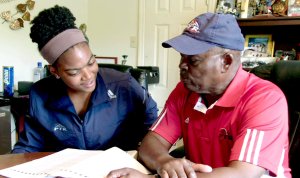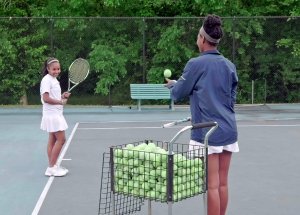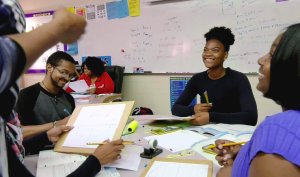Real-World Learning With Internships
See how a training program in high school connects students’ passions to their classroom learning.
Your content has been saved!
Go to My Saved Content.Overview
Outside of Nashville's Hadley Park Community Center, Andi, a timid four-year-old, met her internship coordinator, Joe Goldthreate, for the first time. She was waiting in the car for her two older sisters to finish their tennis lessons.
"It was time for me to start playing, and I wouldn't get out of the car," recalls Andi. "And so he walked up to the window after one of the practices and said, 'If you get out of the car, I'll give you free tennis lessons for life.' He changed that to free tennis lessons until you're 18, and then to free tennis lessons until you graduate from high school," laughs Andi.
Andi is now a rising senior at Nashville Big Picture High School, and she has been interning with Goldthreate since the ninth grade.

When Andi entered Big Picture High School, she had her eyes set on a tennis internship. Learning Through Internships -- or Interests -- (LTIs) are an integral part of Big Picture learning. Students can develop their own internships, like Andi, or seek out existing positions within the community.
When asked what she does at her internship, Andi responds, "I'm learning to be a professional tennis teacher, or a professional tennis player." At 15, Andi became the youngest Professional Tennis Registry (PTR) teaching professional in the world, and she's already teaching students older than she is.
As part of her internship, she teaches students ages 5-18. At 17, she'll soon be teaching professional players from all over the country that come to train with her mentor. Also through her internship, Andi strings rackets (and now has her own stringing business), accompanies Goldthreate at high school speaking events and meetings with the Park Board or the Congress, plays in tournaments, puts on fundraisers, studies for her classes, and attends events like the PTR Symposium, where she networks with other tennis professionals, sharing what they do at their tennis associations, clubs, and PTR offices. And this year, Andi will be a speaker at a tennis convention.
"What’s next for me?" reflects Andi. "I’m either going to college or playing on the pro tour."
Her long-term goal, with her two sisters, is to open a free country club for underprivileged kids. "When we grew up, our tennis program was free. If our mom had to pay for each one of us to go, we wouldn't have been able to afford it. That's something that I want to give to another child."
The Impact of Internships
Andi didn't arrive at Big Picture with the confidence that she has now. "When she first came to me, she was a person that didn't think too much of herself," remembers Goldthreate. She felt overshadowed by her sisters who were both in gifted programs and honors classes. "She has always felt like she wasn't as smart as my other two daughters," explains Sheryl Clayton, Andi's mom and a Big Picture teacher.
Andi's confidence grew as she stepped into a leadership role teaching tennis. One of her students, Ashanti, sees her as a big sister. "Andi taught me that people see you as your attitude and the way you move. She taught me about posture, how you present yourself, everything."


Andi also found her voice through her internship. She's now vocal in class and isn't afraid to ask her teachers for help. "I know if I have a problem, I can talk to my teacher,” says Andi. “That's something I really struggled with my freshman and sophomore year. I would settle for a grade, and I wouldn't go to the teacher to see what I could do to either relearn the content or redo the assignment."
Self-advocacy is one internship outcome that Laura Davis, a Big Picture teacher and advisor, wants for her students. "I hope students walk away from their internships with the ability to self-advocate, ask for help when needed, and find something that will make them passionate both inside and outside of their career."
By exploring their interests and passions through LTIs, students save money and time when they go to college. About 75 percent of college students change their major at least once, and the average college student changes his or her major at least three times before graduating, according to the The Undecided College Student (Virginia N. Gordon, George E. Steele).
At Big Picture, students explore what does and doesn't interest them, and how their interests can translate into a career, experiencing up to nine internships to help them with that discovery. Big Picture teacher Sheryl Clayton explains, "Students who start off thinking they want to work in a daycare, for example, they would do an internship at a daycare, and they would realize very quickly whether they want to be around small children all the time. Our students are miles ahead of a student who goes to college thinking they want to go into early-childhood education, they get out of college, and then realize that's not what they want to do."
Internships are an integral, four-year journey at Big Picture. If you want to engage your students in their learning, we'll show you how Nashville Big Picture High School implements their internship program, and how you can adapt it.
How It's Done
Adapt Big Picture's Internships to Fit Your Resources
Students at Nashville Big Picture attend classes Monday, Wednesday, and Friday. On Tuesday and Thursday, they’re off-campus at their internships. During their three days a week on campus, they have daily advisory that includes group activities, individualized learning, and one-on-one meetings with their advisor. Advisory is also where they work on their internship preparation skills in ninth grade and their internship exhibition presentations each year. Throughout students' internship journey, their advisors are the main contact person for their internship mentors.
Nashville Big Picture is part of a network of Big Picture schools, and not every school offers internships in the same way. If you can't devote two days to internships, or one day -- like Bellevue Big Picture High School in Seattle, Washington -- here are other practices you can adopt to get similar benefits.
5 Ways to Adapt Internships
1. Bring community members into the classroom to talk about their careers. Nashville Big Picture brings students' mentors into the classroom -- or other community members -- to talk about their job and the path they took to get there. "They can talk about their career, education, and things that kids never thought about doing before," says advisor and teacher Laura Davis.
2. Go on a field trip. Big Picture takes their students on many field trips in their freshman year. Do a class survey, and let that guide you on where to go. Laura Davis took her students to a Nashville Sounds game (a minor league baseball team) as a field trip. "It's not just people playing baseball," explains Davis. "There's concessions, HR, engineers, lawyers, there's all kinds of things. The exposure is the biggest part for kids."
3. Help your students volunteer. They can volunteer after school or during the weekends if they can't miss class, suggests Courtney Ivy Davis, Big Picture's LTI coordinator and school counselor. She also stresses the importance of helping your students find meaningful volunteer opportunities that match their interests. One of the great things about Big Picture internships is that students aren't just answering the phone in someone’s office; instead, they're engaged in hands-on projects that a real-life employee would carry out.
4. Let your students explore their interests and passions in the classroom. "You can allow your students to find their interests and passions on their own and pursue that within the classroom without taking two days a week to go into the community," explains Sherry Armistead, a Big Picture teacher and advisor. "Find what students are interested in, even as a class or in small groups." Once your students find their interests, you can incorporate those interests into classroom assignments, presentations, and projects. Nashville Big Picture uses personalized projects as an avenue for students to pursue their interests. You can also explore these three resources from Edutopia on how to personalize your students' learning:
5. Have your students shadow someone in a career they're interested in exploring. Instead of a months-long internship, you can let your students shadow someone for a day. This will give them the hands-on experience in a real-life work environment to see whether they're interested in exploring that career further. In the following nine steps for adopting Nashville Big Picture's internship program, the first four will prepare your students to shadow a professional.
Follow Nashville Big Picture's Internship Model
Step 1: Help Your Students Find Their Interests
Not every student comes to Big Picture knowing what he or she is passionate about. It takes some students four years -- trying internship after internship -- to discover what interests them, and that's OK. Not every student will graduate from Big Picture with a short-, medium-, and long-term plan like Andi is developing, but every student will leave with a better idea of what they are -- and aren’t -- interested in.
Use Interest Inventories and Who Am I? Projects: Big Picture guides students in developing a better understanding of themselves through interest inventories and Who Am I? Projects, like oral and family histories, collages, and autobiographical sketches.
Harley Center, a 2016 Big Picture graduate, discovered his passion for filmmaking from a Who Am I? Project, his first assignment in ninth grade. He made a video documentary about himself. Now, a rising freshman in college, he has made a video for Edutopia highlighting student voice and choice, he has a summer job making descriptive product and service videos, and he’s eager to start the part-time filmmaking job that he'll likely have when he begins college. Harley had five Big Picture internships, none of them related to filmmaking, but he used film to express his learning from each internship, and discovered that filmmaking was his passion.
Sara Greenfield, a seventh-grade teacher from Santa Monica, California, lists Who Am I? Project ideas connected to English and history. The Kidlink Project (a global, teacher-volunteer organization that enables students from around the world to collaborate with each other) lists outlines, discussion questions, and activities for different Who Am I? Projects.
Build Intentional Relationships With Your Students: "I think what a teacher can extract from our internship model is building intentional relationships with students. It starts there," says Courtney Ivy Davis. "Once they establish that relationship, the interest and the passion follows," adds Armistead.
Not every student will identify their interests through an entrance inventory or realize that an everyday part of their life is actually an interest that they can explore. By having conversations with your students, listening to them, and paying attention, you'll catch things that they may not be aware of. Laura Davis explains, "Sometimes I'll point things out to kids that they know they like, but didn't think about in terms of exploring through an internship. For example, I'll say, 'I always hear you listening to music when you come in, or when you get frustrated. Is that something you want to explore?'"
Here are 22 tips from Big Picture educators on how to build intentional relationships with your students, even if you're at a big school.
Step 2: Find Internship Sites
Once your students discover their interests, assign them a career inventory that matches their interests to careers, which will help them identify potential internships. Big Picture students use the school’s online LTI database, the yellow pages, and word of mouth to find local companies or people who fit the career they want to explore. Tapping into your students' family and friend network is a great place to start. "We rely heavily on a friend of a friend of a friend, somebody who knows somebody, and the first thing we do is ask the students," says Courtney Ivy Davis.
Step 3: Set Up an Informational Interview
Help Your Students Prepare for the Informational Interview: Once your students find an internship site that they like, the next step is to set up an informational interview with a potential mentor from that business. Before the interview, Nashville Big Picture prepares students by having them do the following:
- Create a resume.
- Role play interviews with the teachers from their grade-level team, as well as other faculty.
- Practice their phone skills. "We have current and past mentors that will let students call them to practice," explains Laura Davis. "We practice what happens if somebody's rude to you, because that's going to happen on the phone."
- Create a list of 25 interview questions and review them with the LTI coordinator.
Guide Your Students in Scheduling the Interview: Have your students call the site and schedule the informational interview themselves. Once they get the interview, they can let you know when and where they're going, give you the internship site’s contact information, and call you when they've arrived for the interview. "We have a special phone line that they call. It's voice-recorded, and it goes into an email so that I know that they're there," explains Courtney Ivy Davis.
Reflect With Your Students After the Interview: Big Picture students have one-on-one meetings with their advisors to let them know what they've learned, what the interview was like, and whether or not it's a place they want to explore further.
Step 4: Set Up a Shadow Day
If your student wants to continue exploring that career after the informational interview, call the internship site to set up a shadow day. Once it's scheduled, have your students call back to ask about appropriate dress, and make sure they plan for their own transportation. "They spend anywhere from three hours to the entire school day shadowing someone, which can be completely different from the interview," explains Laura Davis. After shadowing someone from the internship site, have your students write a reflection about their experience. If they realize that career isn't for them, it's a success, says Davis. "We feel like we've saved them future time down the line."
Step 5: Set Up Your Students' LTI
If your students discover they want to continue exploring a profession after shadowing someone, set up a meeting with the person they shadowed. Nashville Big Picture advisors will call their students' potential mentor to arrange a meeting between the advisor, mentor, and student to discuss the Big Picture internship program, their policies, and the expectations of being a mentor. They'll also bring the mentor agreement form and the intern agreement form for both parties to sign. If you find that the person you're calling to be a mentor is on the fence, meet with them one-on-one first to tell them more about the process, suggests Davis. This way, a student won't get their hopes up if the potential mentor says no. Once the mentor agrees, do a background check on him or her. Nashville Big Picture does both a district and state background check.
Step 6: Communicate With Your Students' Mentors Throughout Their Internship
Communicate with mentors weekly to see what projects your students are working on, their successes, and where they might need improvement. "It can be something as simple as a text, an email, or depending on the time of the month -- or the rotation that the advisor has set up -- it can be a face-to-face visit," explains Courtney Ivy Davis.
Advisor Laura Davis tries to make on-site visits every two to three weeks. Nashville Big Picture has four teachers on their freshmen team. On Tuesdays and Thursdays, three of them spend the day making on-site visits to check in with students and their mentors, and one teacher will stay at Big Picture in case a mentor is on vacation or sick and that student intern needs to return to campus.
All on-site visits are scheduled with the mentors, but sometimes it's great to surprise your students so that you can see how they naturally act during their internship, says Laura Davis. Also, let your students' mentors know that they can schedule face-to-face visits if they want to discuss issues between the three of you.
Step 7: Get Mentor Feedback on Your Internship Program
Give your students' mentors a survey to collect feedback on how to improve your internship program. Nashville Big Picture does this twice a year. They include questions like:
- How can we improve our program?
- What's working?
- What's not working?
- How can we better assist you?
Step 8: Give Your Students a Platform to Share Their Work
Have your students keep a journal to reflect on their work and learning throughout their internship. Nashville Big Picture students keep a journal and create a portfolio of their work to present to their family, friends, peers, mentor, Big Picture staff, and community members. This helps students reflect on what they did, discover or reinforce their strengths -- as well as areas for improvement -- and helps them decide whether they want to pursue this career further.
Step 9: Make Sure That Mentors Are Evaluating Your Students
At the end of the year, give all mentors a student evaluation form, or meet with them in person to share their evaluation with you. When students are in the moment, "they don't always tell you about all the great things they're doing," says Laura Davis, "and I like to hear from the mentor's point of view about what specific things they've been working on."
Use the evaluation meeting to plan the next steps for your student's internship for the following year. Will they continue with the same mentor? Would it be best for your student to work with another company so that they can experience the diversity in work culture and styles within that field? Or does your student want to explore a different career? These are all questions that you can wrap up in this last meeting to transition your student to his or her next internship.
